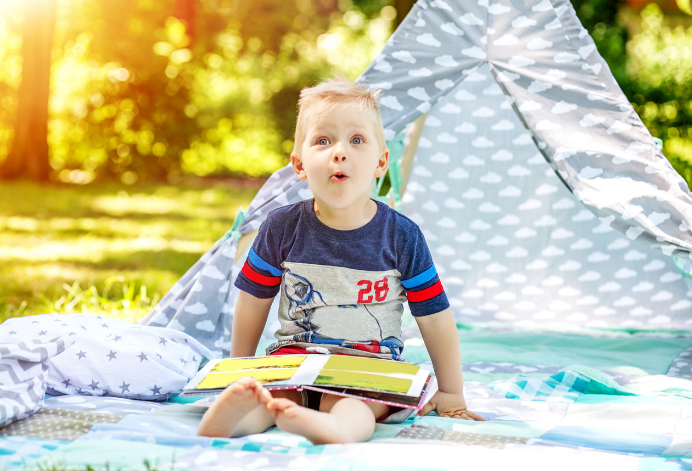
First – provide warmth, love, and emotional support.
Yes, you are allowed to show emotions! In fact, it is important that your child sees all sides of you, so that they feel safe to express their own emotions around you. As parents, there will always be times that we feel fed up, like there is nothing more we want to do than scream. This is completely okay! However, if you find that there are moments in which you cannot control your emotions around your child, it is important to take a moment and walk away and take care of yourself.
You can go on a walk, talk to someone you trust, read books, watch your favorite TV show, or spend some time looking at social media. Doing things that you enjoy will make it much easier to help your child through high emotions while also addressing their misbehavior.
Second – Stay calm and be patient.
This is much easier said than done! As parents, we want the best for our children, and we want them to grow to be respectful and caring adults. So how do we stay calm during tense moments, and why is it important to be calm?
Staying calm when our child is making us angry or embarrassing us can feel impossible. Do we just conceal our feelings and pretend everything is okay? The simple answer is no.
To control our emotions while we enforce discipline, we should first acknowledge what we are feeling when our child misbehaves. We should ask ourselves: Am I angry at my child? Am I disappointed? Am I embarrassed?
If we find ourselves to be upset, we might want to walk away from our child for a moment, take a few deep breaths and silently count to ten, or just breathe until we are calm again. Eventually, we will be able to explain why we are upset in a calm voice, and exercise patience as they explain their side of the story. This will not only make your child feel heard, but it will also teach them how to control their own emotions when they get upset.
Third – don’t forget to explain why they are being disciplined and think before speaking.
In the heat of the moment, we might tell our child, “Listen to me, because I said so!” It is okay to say this, it happens. When our child is calmed, we just want to explain our reasoning, so that our children understand why their behavior is inappropriate. If the child does not seem to understand, it might be helpful to explain the consequences of their actions through a story. Think of the story or a saying that you might have learned as a child. Stories and sayings are a great way to teach children about appropriate behaviors.
Now that we have a foundation for our behaviors as parents, let’s explore different ways to discipline and find what works for you!
With an influx of information from the media, it can be overwhelming to find the “correct” way to discipline. The truth is, there is no right way to discipline! We will discuss a few strategies that tend to work on preschoolers, but every child is different, so it is okay if some of these strategies do not work; you can always try a different one! Do not spank or use any other form of physical punishment, as this might lead to emotional problems as the child gets older. Children with parents who are calm during discipline are more likely to be social and have good relationships. If you have used spanking or physical punishment in the past, it’s okay. It is never too late to change the way we discipline our children!
So, what can we do instead? Here are just a few ideas on what to do in situations where you may not know how to respond to your child’s misbehavior:
Give them consequences. A child might not want to pick up their toys. It would be easier to just clean up the mess for our preschoolers, which is okay to do every once in a while. However, asking them to clean up their messes will help them understand that their actions have consequences. If they refuse, we can take away their toys and remind them that if they want to play, they also need to clean up after themselves. If they change their mind and do clean up, we might tell them, “Great job cleaning up!” After hearing this, the child will likely feel good about cleaning their mess, and might even clean their messes in the future.
Ignore the behavior as long as they are safe! For example, a child is crying and screaming at the store because I don’t want to buy them a toy. Yes, yes, I know it is embarrassing to have your child screaming, and everyone looks at you like they have never experienced it themselves. It’s okay, let everyone stare and ignore the behavior until your child calms down.
Tell your children what you want them to do instead of telling them what not to do. For example, instead of saying don’t jump on the bed, you can say something like “The bed is for sleeping, you can go jump on the living room floor or outside.” Or, if they are running and we don’t want them to run, we can say something like “Let’s use our walking feet.”
Now that you have some ideas of how to discipline your children , remember to follow through with the consequence and do not fall for guilt-tripping!
Following through with consequences will help our children know that we are serious. If we tell our children that their iPad or toy will be taken away if they do not brush their teeth, it is important that we keep our word. If we do not follow through, this behavior might continue because they may assume that we are not serious, or that we won’t do it anyways. Staying true to the consequences will help them understand that we mean what we say, and that they will not get away with this behavior in the future.
It take stime and practice to find ways to discipline our children in a way that works for them and helps them learn , so be patient with your self and your children!
Authors: Emma Swertfeger & Guadalupe Díaz Lara
Translation by: Nancy Perez Sanchez
Learn more about the Oregon Parenting Education Collaborative <http://www.health.oregonstate.edu/opec> and read our blog < https://blogs.oregonstate.edu/opec/>
< https://oregonstate.edu/> © 2024 Oregon State University <https://oregonstate.edu/copyright>


